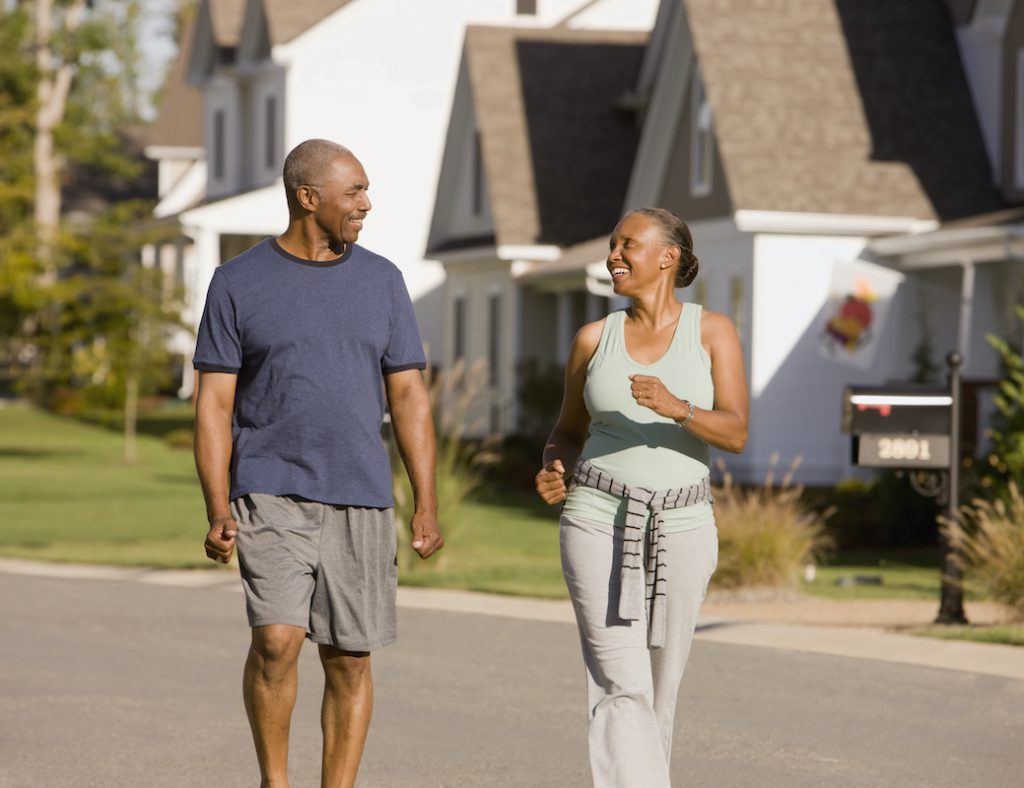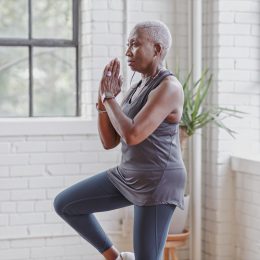The Incredible Power of a Post-Meal Walk
Walking after a meal can blunt the glucose spike that follows eating. Use these strategies to reap the full benefit.

It’s natural for blood sugars to rise after eating. But if you are older or have diabetes or prediabetes, they can rise to a dangerous level that can damage your health over time. Making a habit of walking after dinner can make a huge difference. Here’s how.
Why Blood Sugars Rise After Meals
“What you eat sends [blood sugar] up, and then insulin gradually pushes it back down,” explains Daniel Cox, Ph.D. Cox is a University of Virginia professor researching the effectiveness of lifestyle changes on managing type 2 diabetes.
After a meal, your body digests carbohydrates into glucose, which enters the bloodstream. Rising blood glucose signals your pancreas to release insulin. This hormone tells other cells in your body to take up that glucose from your blood to store or use for energy.
If blood glucose rises too high, and your cells can’t take it up quickly enough, that excess glucose in the blood can cause damage over time.
If you have diabetes, your pancreas may not make enough insulin, or your cells don’t respond to it as well as they used to. Even if you don’t have diabetes, you may experience higher blood sugars as you age.
“As we get older, the pancreas becomes more sluggish and takes a bit longer to respond with insulin. And, that response may not be as strong,” says Loretta DiPietro, Ph.D., M.P.H. She’s a professor of exercise and nutrition sciences at the Milken Institute of Public Health at George Washington University.
Try a SilverSneakers Walk Strong (Express) Class! In just 15 minutes, your expert instructor will lead you through moves aimed to ease lower body stiffness, strengthen your stability muscles, and build confidence. View the schedule and RSVP here.
How to Use a Post-Meal Walk to Lower Blood Sugar
Whether you have diabetes or not, a post-dinner walk can help bring down high blood sugars after eating. When your muscles are working, they will take up glucose for energy—without insulin, explains Cox.
“As they use glucose, they’re sucking it out of your bloodstream and lowering your blood sugar,” says Cox.
As an added benefit, a bout of exercise can improve insulin sensitivity for several hours after, says Cox. This can make your cells more effective at absorbing blood glucose even while you’re not exercising.
For these reasons, physical activity is a cornerstone of diabetes management or prevention. Use these tips to tap into the power of a post-meal walk.
Tip #1: Get Moving 30 Minutes After You Put Your Fork Down
If you want to lower post-meal glucose, it needs to be elevated first. So you’ll want to give your body time to digest your food and break it down into glucose.
Typically, by the 30-minute mark, “your blood vessels are swimming with glucose molecules,” DiPietro says. So that’s a good time to start.
Going too soon after a meal can slow the digestion process, delaying the blood glucose rise, Cox says.
“If your blood glucose is not elevated, then the exercise isn’t going to lower your blood glucose very much,” Cox says. “It will briefly improve insulin resistance, but if you want to have the biggest impact on lowering blood glucose, your blood glucose has to be high in the first place.”
Try not to wait longer than 90 minutes, Cox says. For those without diabetes, blood sugar goes back down to normal around then.
Tip #2: Walk for at Least 15 Minutes
In a small study coauthored by DiPietro, participants saw blood-sugar benefits with just 15 minutes of post-meal walking. Still, going for 30 minutes or longer can only help.
Cox points out that the amount of sugar in your blood following a meal depends on what you ate. For example, a bagel with cream cheese will boost blood sugar higher than a single piece of rye toast.
“If you eat the bagel, you need a lot more exercise to bring that blood glucose down,” he says, “because there’s more carbohydrate in it.”
Recommended reading: 6 Surprising Foods That Can Spike Blood Sugar
Tip #3: Go at a Moderate Pace
“For blood glucose control, you’d be surprised at how little you have to do with regard to intensity,” DiPietro says.
The participants in her study walked at a light-to-moderate pace — about as fast as you’d go when walking a dog or chatting with a friend, she says.
But to improve insulin sensitivity, you’ll need to go a bit quicker, at a moderate to vigorous pace, Cox says.
“When I walk, I try to go at a brisk pace and I swing my arms,” Cox says.
Higher intensity can also help if you’re trying to lose weight or improve cardio fitness, DiPietro notes.
Try the walking workouts and tips from our Power Your Walk Challenge! Whether you’re just getting started, or looking to up your walking game, these strategies will help you reach your goals.
Tip #4: If You Can Do Only One Post-Meal Walk, Do it After Dinner
DiPietro and Cox both note that people tend to sit around after the evening meal, but that’s the most important time to take a walk.
Subscribe to our newsletter
It's quick and easy. You could be one of the 13 million people who are eligible.
Already a member? Click to discover our 15,000+ participating locations.
Follow Us
“Dinner is our biggest meal,” DiPietro points out. And pancreatic function tends to reach a low point in the evening, she says, making it harder for your body to clear glucose from dinner. A quick walk can help pick up the slack.
Cox adds that your evening blood glucose level determines how much sugar will be in your blood while you sleep.
“If it’s high, it’s going to stay high throughout the night,” he says. “And if it’s high throughout the night, that glucose has more opportunity to do its damage.”
Ideally, you want to walk after each meal, DiPietro says, but if that’s not doable, at least try to walk after dinner.
Tip #5: If You Can’t Walk, Pick Another Activity
Walking isn’t the only physical activity that can lower blood sugar. Anything that gets you up and moving around after a meal will help keep your blood sugar in check.
“It can be climbing up and down your stairs, walking around the house, bicycling on a stationary bike, using handheld or ankle weights — anything that contracts the muscles,” DiPietro says. “It can even be standing up during commercials and marching in place.”
Need inspiration? Head to the SilverSneakers YouTube channel where you’ll find hundreds of workouts you can do anytime, anywhere. If the weather’s not cooperating, try this 10-minute walking in place workout that you can do inside.
Tip #6: Be Consistent
If you want to keep getting the benefits of post-meal activity, you need to do it on a regular basis. The American Diabetes Association recommends 150 minutes or more of exercise each week. This should be spread out over at least five days, with no more than two days in a row of inactivity.
The best way to meet that goal is to make it part of your routine. DiPietro suggests thinking of your daily walks as you would daily medication.
A walk can also be a chance to call someone on the phone, listen to an audiobook, or just clear your head, says Cox.
“Don’t think of post-meal walks as just a way to lower your blood glucose,” he says. You can also time errands, chores, or dog walking around post-meal walks. “For me,” says Cox, “it’s certainly not dead time — it’s productive time.”
Take Your Favorite SilverSneakers Classes Online!
SilverSneakers members can access live fitness classes and wellness workshops through SilverSneakers LIVE. See the latest schedule and RSVP for classes here.
Not a member? If you have a Medicare Plan, it may include SilverSneakers — at no additional cost. Check your eligibility instantly here.





